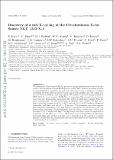Discovery of a soft X-ray lag in the ultraluminous X-ray source NGC 1313 X-1
Author(s)
Kara, E; Pinto, C; Walton, D J; Alston, W N; Bachetti, M; Barret, D; Brightman, M; Canizares, C R; Earnshaw, H P; Fabian, A C; Fürst, F; Kosec, P; Middleton, M J; Roberts, T P; Soria, R; Tao, L; Webb, N A; ... Show more Show less
DownloadAccepted version (401.7Kb)
Open Access Policy
Open Access Policy
Creative Commons Attribution-Noncommercial-Share Alike
Terms of use
Metadata
Show full item recordAbstract
© 2019 The Author(s). Ultraluminous X-ray sources (ULXs) provide a unique opportunity to probe the geometry and energetics of super-Eddington accretion. The radiative processes involved in super-Eddington accretion are not well understood, and so studying correlated variability between different energy bands can provide insights into the causal connection between different emitting regions. We present a spectral-timing analysis of NGC 1313 X-1 from a recent XMM–Newton campaign. The spectra can be decomposed into two thermal-like components, the hotter of which may originate from the inner accretion disc, and the cooler from an optically thick outflow. We find correlated variability between hard (2–10 keV) and soft (0.3–2 keV) bands on kilosecond time-scales, and find a soft lag of ∼150 s. The covariance spectrum suggests that emission contributing to the lags is largely associated with the hotter of the two thermal-like components, likely originating from the inner accretion flow. This is only the third ULX to exhibit soft lags. The lags range over three orders of magnitude in amplitude, but all three are ∼5–20 per cent of the corresponding characteristic variability time-scales. If these soft lags can be understood in the context of a unified picture of ULXs, then lag time-scales may provide constraints on the density and extent of radiatively driven outflows.
Date issued
2019-12Department
MIT Kavli Institute for Astrophysics and Space ResearchJournal
Monthly Notices of the Royal Astronomical Society
Publisher
Oxford University Press (OUP)
ISSN
0035-8711
1365-2966